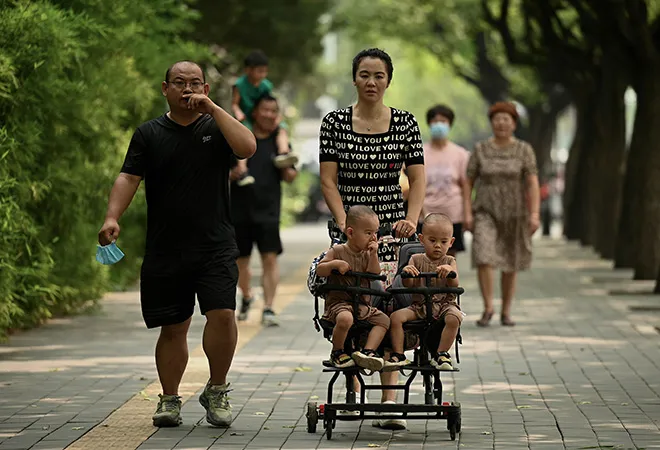-
CENTRES
Progammes & Centres
Location
China’s declining population does have positive implications but it needs to be offset by the increasing productivity of the existing workforce

The news that China’s population had shrunk was not actually new. In fact, there have been suggestions that the Chinese fudged the figures of their National Population Census for 2020 by boosting the figures of youngsters born between 2006-2020 by some 14 million. At the time, the Chinese claimed that the growth of this cohort by 13.8 percent was a sign that the policy of allowing couples more than one child had been successful. Actually, it had been clear since 2016 that the country’s population was shrinking.
Formally, at least the Chinese have now reported that their population had declined for the first time since 1961. Earlier in January, the National Bureau of Statistics reported a drop of 850,000 people in a population of 1.4 billion. In essence, China’s population decline means there will be fewer people to make up the economic heft of the country and these fewer people will have to support a growing number of older persons. By 2100, China is projected to have a workforce—counted as people of ages 15-64—of just 400 million as against nearly 1 billion today.
China’s population decline means there will be fewer people to make up the economic heft of the country and these fewer people will have to support a growing number of older persons.
While all countries will reach a point where their population will begin to decline, China’s trajectory has been shaped by its draconian policy of the mid-1980s that permitted only one child per family. This not only skewed its sex ratio through gender-selective abortions but has led to the precipitous shrinkage of its population. Since 2016, couples have been allowed to have two children, but it is proving difficult to change attitudes which are born primarily out of concerns relating to the cost of rearing children.
The demographic data, coming at a time when the economy is slowing down and a COVID wave is disrupting the country, is not good news for the country. This is the inflection point that will change the way the world looks at China and the way it looks at itself.
Since the 19th Communist Party of China Congress in 2017, China has been emphasising the importance of high-quality development. In his speech to Congress, Xi Jinping acknowledged that the problem now was “unbalanced and insufficient” development. There were challenges in the gap between urban and rural regional development and income distribution. There were problems in the area of employment, education, medical care, housing, and elderly care. Almost all of these will get accentuated by the changed demographics.
Take the area of elderly care. According to the 2020 census, some 264 million people, 18.70 per cent of the population, is above the age of 60. This will increase to 400 million by 2035 or 30 per cent of its population. In 2020 the government hinted it would extend the retirement age beyond the current 60 for men and 55 for women.
A declining population will ease the pressure on the environment, enhance China’s per capita income, lower its unemployment rate, raise wages, and get more women into the workforce.
A report by the Ministry of Human Resources and the Chinese Academy of Social Sciences warned that pension funds for urban workers could start running deficits in 2028 and become insolvent in 2035 because of the demographic situation.
Chinese experts are now arguing that negative population growth does not automatically mean negative economic growth. As of now China still has a huge population with a super-large market and strong consumption. However, over time, it will need to enhance the quality of its working population through investment in education. A declining population will ease the pressure on the environment, enhance China’s per capita income, lower its unemployment rate, raise wages, and get more women into the workforce. But it needs to be offset by the increasing productivity of the existing workforce.
The challenge before China is to sharply increase the productivity of its workforce. Measured in terms of GDP per hour worked in 2021, Luxembourg at US$136.45 topped the list of countries with the highest labour productivity. Most well-off countries like Singapore, the United States, and various EU countries were in the range between US$ 50-70, China was US$13.53 and India at US$8.47. This metric tells us a lot about the efficiency and quality of human capital in the production process in a given context. Jobs based on cheap labour have already begun to move away from China and so there is a need for the country to create more high-wage, high-value jobs.
Automation and Artificial Intelligence are being viewed by many as the “magic bullet” that will help China to overcome the challenges of its demographic shrinkage. According to the International Federation of Robotics, China has become a global leader in this area with the largest stock of industrial robots. As of 2022, it has overtaken the US in robot density in the manufacturing industry, but both are behind South Korea, Singapore, Japan, and Germany. Given China’s status as the factory of the world, this is not a surprising development.
Even so, by the end of 2021, China accounted for 30 percent of the worldwide installed base of 3.5 million units of industrial robots, with more than 1 million deployed in China. That compared with 12 percent in South Korea, 10 percent in Japan and 9 percent in the US.
Automation and Artificial Intelligence are being viewed by many as the “magic bullet” that will help China to overcome the challenges of its demographic shrinkage.
But it remains to be seen whether automation can provide a steady increase in the productivity of the workforce. While it will help upgrade manufacturing and supply chain, there are those like Huang Wenzheng, a demographer, who say that it will do little to boost domestic consumption or address the demographic issue.
But for increasing the productivity and quality of its workforce China needs to upgrade its education and skilling system. But this seems to be a problem area. According to the census, there were 218 million people with a university education. But the average number of years of education received by adults over 25 years was just 7.8 as compared to 12-14 years for developed countries. This is a measure of just how far China has to go to meet the needs of the high-quality economy that it wants to become.
The views expressed above belong to the author(s). ORF research and analyses now available on Telegram! Click here to access our curated content — blogs, longforms and interviews.

Manoj Joshi is a Distinguished Fellow at the ORF. He has been a journalist specialising on national and international politics and is a commentator and ...
Read More +